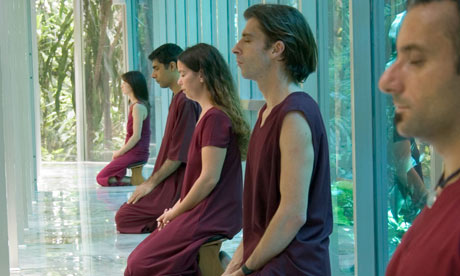
There's this thing I do, every now and then. I will step away from the comforts of my life: my spouse and child, my home and dog. I pack a small bag with two pairs of old linen trousers, three T-shirts, a thin cotton wrap and flip-flops. Then I make the trek to a Vipassana meditation centre and begin a monastic life for 10 days.
These centres are scattered around India and all over the world. I have been making this trip for more than 10 years, varying my location each time. Wherever you go the retreat has an identical structure and discipline: 10 days of silence, meditating from 4am to 9pm, with short breaks for meals and rest.
You rapidly get used to this routine. The morning wakeup bell at 3.45am is followed by a quick bath in warm water, then a silent walk to the main meditation hall, which can seat 200. We sit in our designated spots and meditate until breakfast, a simple vegetarian meal consumed in silence. More meditation, this time alone in our tiny cells – a room no bigger than a sofa and lit only by a round window near the ceiling – until lunch at 11am. After a short period of rest there is more meditation from 1pm to 5pm. Then a glass of lime juice and a brisk walk in the designated area. A lecture, where we learn the theory behind our meditative experiences, more meditation and bed at 9.30pm.
Men and women are segregated throughout the compound; we live and eat separately. Returning meditators may get a room of their own, but newbies usually have to share. Those on retreat include students, corporate executives, artists, housewives; rich and poor. One of the great principles of Vipassana is that no fee is charged. Centres are instead maintained by the donations of those who have completed a meditation course. This opens the doors to everyone and places every meditator in the position of being a bhikshu (monk), who for those 10 days possesses nothing. It is very humbling and wonderfully freeing.
Vipassana means "to see things as they really are". It is a pre-Buddhist meditation technique that was revitalised and popularised by Gautama Buddha 2,500 years ago. The instructions, played out over the speakers, are straightforward: observe your breath for three days, then observe your body for seven. Simple, the way instructions for running a marathon can be made reductively simple: take a step or two; continue for 26.2 miles in a speedy fashion.
Sitting still and silent on my cushion, I learn that observing my breath at the point where it exits the nostrils focuses the brain. That by observing my breath, I am learning to observe myself. Anger and peace at the subtlest level are all in my breath. For breath, I learn, is spirit itself.
As the practice deepens, my chaotic thoughts and emotions, memories fond and painful, yield all manner of sensations: pain in my joints, leaps in my chest, tingling behind my neck. I am told not to suppress them, but not to chase after them either. I am simply to observe them on their journey through me. When emotions are observed, not suppressed or amplified, they filter through quicker, leaving a smaller residue behind. Sensations rise and pass. Just observe, they say. Don't react. This is unbelievably difficult.
The journey deepens. Heavier sensations dissolve from the body and awareness sharpens. Meditating for hours is throwing myself wide open: I am part of a rush of energy far bigger than myself. When I step out of my cell, the world is unimaginably bright. I notice the intense flavour of steamed rice; the music of distant everyday voices. I am extraordinarily peaceful. I carry this peace back with me to my daily life, along with the clarity and mindfulness that only peace can bring.
That is one kind of experience, but not all Vipassana retreats have been filled with peace. One, in particular, undertaken when I was under severe emotional stress, stands out. I stepped inside, and was blasted by the anger and fear and hurt and sorrow that I had packaged away in my daily life. These feelings brought forth tears and heat and chills and fever as they rose to the surface – so many layers that it seemed as if it would never end. The discipline required to just observe the sensations as they happened, to not distract myself from them, to not run away, was enormous. Layer by layer they rose, in full force, before lifting away months of anguish and suffering. At the end I was drained, exhausted, limp – but cleaned out.
The gift of Vipassana to my writing life is unparalleled: my relationship with words is more intense and playful; I am sensitive not just to my work but how I work. The way I observe people changes – I am able to step away from myself more easily, from the constraints of my own life and experience and understand them for who they are.
I am both faster in the things I do, and calmer in the manner I do them. My world is lighter and yet more meaningful. Vipassana is the single most powerful thing I do.
The Hope Factory by Lavanya Sankaran is published by Tinder Press

